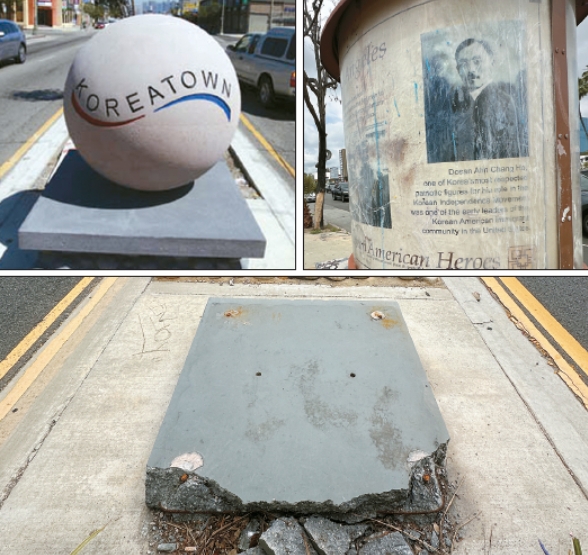After the Korea Daily reported that a sculpture representing LA Koreatown had been removed without the knowledge of the Korean-American community and placed in a city warehouse, community leaders took actions to reinstall symbolic sculptures in Koreatown.
According to James An, president of the Korean American Federation of Los Angeles (KAFLA), the organization has scheduled a meeting with L.A. City Councilmember Heather Hutt (10th District) in the second week of May to discuss reinstalling the sculptures. The two sides are currently working on a specific meeting date.
The two sculptures that were removed were the sphere-shaped “Koreatown” sculpture on Olympic Boulevard (near Kenmore Avenue) and a small “tower” sculpture (near Hobart Boulevard). They were originally funded by the city of Los Angeles in 2011 as part of the Olympic Boulevard renovation project. The sculpture, which is inscribed with the words “Koreatown” and “Welcome,” along with a Taegeuk symbol, has been a symbol of Koreatown for more than a decade.

The actual sculpture was installed in a location where the median strip was too low, allowing cars to run over it in the event of an accident, causing damage.
The city of Los Angeles, which was responsible for the negligence, is also considering whether to reinstall the sculpture. “We are in discussions with the Bureau of Street Services to re-evaluate the Olympic Boulevard vandalized sculpture issues, including the Koreatown sculptures,” said Devyn Bakewell, director of communications for Hutt’s City Council office. “Once the evaluation is complete, we will prioritize maintenance and repair needs based on our budget.”
Some say the removal of the Koreatown sculptures was also due to indifference from the Korean-American community.
“Unlike the first generation, the 1.5 and second generations seem to be somewhat indifferent to the concept and importance of Koreatown,” said Hyejung Cho (33), who lives in a condominium near Olympic Boulevard. “Even though the city of Los Angeles is responsible for managing Koreatown, I think the Korean-American community needs to be more self-reflective for not taking care of Koreatown properly.”
In 2011, the ceremony to unveil the sculpture attracted a lot of attention, with the LA City Council, the Consulate General of the Republic of Korea in Los Angeles, and Korean-American organizations attending.
However, the sculpture was not properly maintained and remained in a state of disrepair for years before being removed without anyone noticing.
In addition to the removal of the sculpture, Olympic Boulevard and Vermont Avenue in Koreatown are also vandalized with graffiti, including a plaque about Dosan Ahn Chang Ho and information boards about the history of Koreatown.
Currently, the nonprofit Koreatown Youth and Community Center (KYCC) is in charge of graffiti removal in Koreatown. When complaints are received through the LA city hotline (311), KYCC teams go to the site to remove the graffiti.
“Korean-Americans often think that it’s ‘someone else’s business,’ but if you see graffiti that harms the appearance of Koreatown, please actively report it to ‘311,’” said Steve Kang, director of external affairs at KYCC. “In the case of the Koreatown signboard, the councilmember’s office has to manage it through special funding, but we are also looking into whether we can remove it.”
BY YEOL JANG, JUNHAN PARK [jang.yeol@koreadaily.com]

![Son Heung-min to LAFC? Tottenham Star Nears MLS Move Tottenham Hotspur and Korea national team captain Son Heung-min is pictured on March 20. [YONHAP]](https://www.koreadailyus.com/wp-content/uploads/2025/05/0516-SonHeungmin-100x70.jpg)

![‘Squid Game’ S3 Breaks Netflix Record Despite Mixed Reviews A still from the third and final season of Netflix's series ″Squid Game″ (2021-2025) [NETFLIX]](https://www.koreadailyus.com/wp-content/uploads/2025/06/0630-SquidGame-100x70.jpg)
